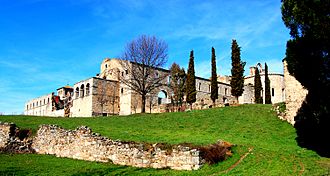Monastery of Pelayos facts for kids
Quick facts for kids Monastery of Pelayos |
|
|---|---|
|
Monasterio de Santa María la Real de Valdeiglesias (Spanish)
|
|
 |
|
| General information | |
| Status | ruins |
| Type | monastery |
| Location | Pelayos de la Presa, Community of Madrid, Spain |
| Coordinates | 40°21′57″N 4°19′20″W / 40.365944°N 4.322192°W |
| Owner | Ayuntamiento de Pelayos de la Presa |
| Official name: Monasterio de Pelayos (Ruinas) | |
| Type | Non-movable |
| Criteria | Monument |
| Designated | 23 November 1983 |
| Reference no. | RI-51-0004982 |
The Monastery of Pelayos is an old Cistercian monastery. It is now mostly in ruins, meaning it is broken down and not complete. You can find it in a town called Pelayos de la Presa, which is in the Community of Madrid, Spain. This historic place was once a busy home for monks.
Contents
A Look at the Monastery's History
The Monastery of Pelayos is found on the north bank of the Arroyo de la Presa stream. It is very close to the homes in Pelayos de la Presa.
How the Monastery Was Built
The Cistercians, a group of monks, started building this monastery in the 12th century. That's a very long time ago! Over the years, especially starting in the 15th century, the monastery was updated and changed a lot.
Why It Became Ruins
In 1836, something important happened in Spain called the desamortización. This was when the government took over many properties owned by the church, including monasteries. The monks had to leave the Monastery of Pelayos. After they left, the building slowly started to fall apart and became the ruins we see today.
Saving the Ruins
Later, an architect named Mariano García Benito bought the ruins. He spent time and money trying to fix them up and make them stable again. In 2003, Mr. García Benito gave the monastery to the local town council.
A Protected Landmark
Because of its history and importance, the Monastery of Pelayos was declared a Bien de Interés Cultural. This means it's a special landmark that needs to be protected. This official declaration happened on November 23, 1983. It was published in the official government newspaper, the BOE, on February 14, 1984.
See also

